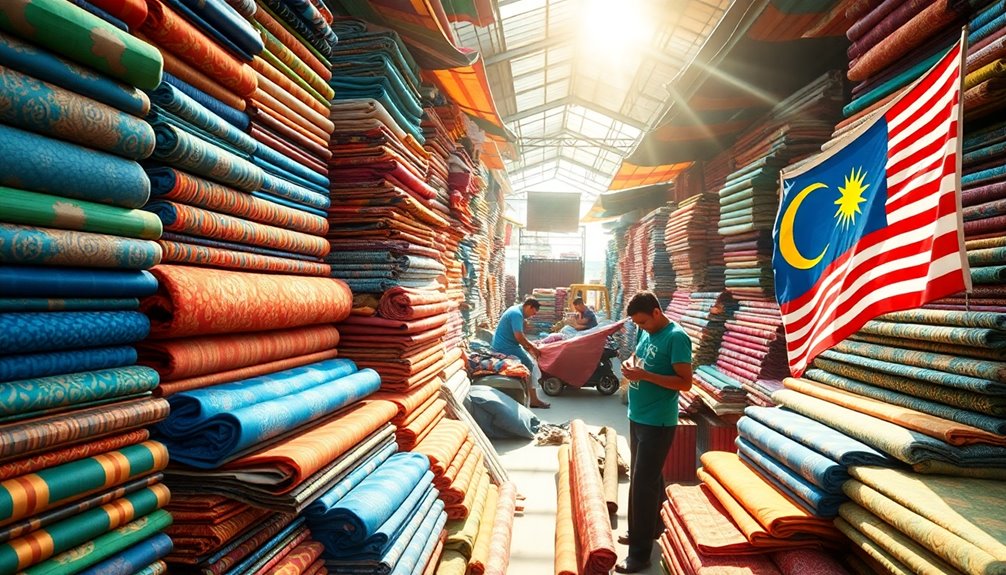In 2024, you've likely noticed that Turkiye's fabric imports from Malaysia saw a significant increase of 20%, now valued at $128 million. This surge reflects a shift in sourcing strategies as Turkiye diversifies its suppliers amid challenges in traditional markets like the EU and US. Despite rising imports, domestic textile production is on the decline, illustrating the complexities of the current market. Stay tuned to uncover more about these evolving trade dynamics and their implications.
Key Takeaways
- Turkiye's fabric imports from Malaysia grew by 20% in 2024, totaling $128 million, reflecting shifts in global trade dynamics.
- This increase aligns with a broader 15.82% rise in Turkiye's overall apparel imports.
- Malaysia has not been a traditional supplier, indicating a strategic sourcing shift for Turkiye.
- Despite rising imports, Turkiye's domestic textile production has declined in recent years.
- The increase in imports from Malaysia may provide new trade opportunities amid challenges in EU and US markets.

As Turkiye's fabric imports from Malaysia surged by 20% in 2024, reaching $128 million, it's clear that shifts in global trade dynamics are reshaping the textile industry. You may notice that this increase aligns with a broader trend, as Turkiye's overall apparel imports rose by 15.82% during the first ten months of 2024 compared to the previous year. This growth suggests that Turkiye is actively seeking to diversify its sourcing strategies amid competitive pressures from major suppliers like Vietnam and India.
Turkiye's fabric imports from Malaysia surged 20% in 2024, highlighting a strategic shift in sourcing amid competitive pressures.
While Malaysia isn't traditionally a primary supplier for Turkiye, this recent uptick indicates a strategic pivot. Perhaps you're aware that Turkiye's textile and clothing exports faced challenges in 2023, with declines in major markets like the EU and the US. The increase in imports from Malaysia could be a response to these economic factors and changing trade policies. It seems Turkiye is looking to strengthen its fabric supply chain and adapt to fluctuating market demands.
You might find it interesting that, despite the increase in imports from Malaysia, Turkiye's textile production declined in 2023 and the first half of 2024. This decline illustrates the complexities of the current economic landscape, where rising import values don't always correlate with domestic production growth. In fact, Malaysia imported 69,695 shipments of fabric from March 2023 to February 2024, showcasing its active role in the global fabric market.
Additionally, while Turkiye's apparel imports from Africa have seen a rise, exports to that region have diminished, further complicating the trade dynamics.
Looking forward, increased imports from Malaysia could open up new opportunities for bilateral trade. However, Turkiye must navigate several challenges to maintain competitiveness in crucial markets such as the EU and the US. By diversifying suppliers and exploring new markets, Turkiye can mitigate risks in its textile sector.
The global textile market remains highly competitive, and adapting to these changes is essential for future success.
Frequently Asked Questions
What Types of Fabrics Are Imported From Malaysia to Turkiye?
Turkiye imports various types of fabrics from Malaysia, including polyester fabrics, which are versatile for apparel and home textiles.
You'll also find PU fabric, known for its durability and water resistance, ideal for clothing and upholstery.
Additionally, coated cable is used for industrial insulation, while top coat fabrics offer extra protection.
Lastly, polyurethane laminate is popular for its strength and flexibility across different textile applications.
These imports cater to diverse market needs.
How Does the 20% Increase Compare to Previous Years?
Imagine a garden where each flower represents a year of trade. In this garden, the blooms of fabric imports from Malaysia have steadily grown.
This year's 20% increase stands tall among previous years, revealing a vibrant trend. While past years may have seen modest growth, this leap is like a sunflower reaching for the sun, indicating a flourishing relationship.
You can see how this growth shapes Turkiye's textile landscape, promising brighter days ahead.
What Are the Main Reasons for This Import Increase?
You'll find several key reasons behind the increase in fabric imports from Malaysia to Turkiye.
Growing market demand for quality textiles, competitive pricing, and Turkiye's economic growth play crucial roles.
Additionally, improved supply chain efficiency and favorable currency fluctuations make Malaysian fabrics more appealing.
Effective marketing strategies and participation in trade shows further boost awareness, while diversifying suppliers helps Turkiye reduce dependence on traditional sources, enhancing overall import dynamics.
How Does This Impact Turkiye's Domestic Textile Industry?
You mightn't realize it, but the surge in fabric imports could shake up Turkiye's domestic textile industry.
As competition intensifies, local producers face pressure to innovate and maintain quality. This shift may lead to market saturation, affecting demand for your locally made fabrics.
Additionally, job stability could be at risk, and you might see factories struggling to keep up.
Adapting to these changes will be crucial for survival in this evolving landscape.
What Future Trends Are Anticipated in Fabric Imports From Malaysia?
You can expect that fabric imports from Malaysia will continue to rise in the coming years.
As Malaysia's textile industry grows, driven by urbanization and global demand for quality fabrics, your market will likely see an influx of diverse textiles.
With Malaysian polyester fabric projected to expand and the overall market strengthening, you'll benefit from increased variety and innovation in the fabrics available to you, enhancing your domestic textile sector.
Conclusion
As you reflect on Turkiye's impressive 20% surge in fabric imports from Malaysia, valued at a striking $128 million, you can't help but wonder what this means for the future. Will this booming trade lead to deeper ties between the two nations? Or could it spark competition that reshapes the market landscape? The possibilities are tantalizing, leaving you eager to see how this vibrant exchange unfolds in the coming months. The story is far from over.










